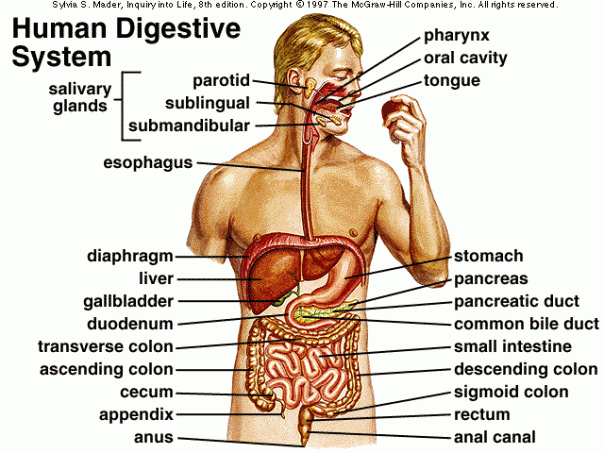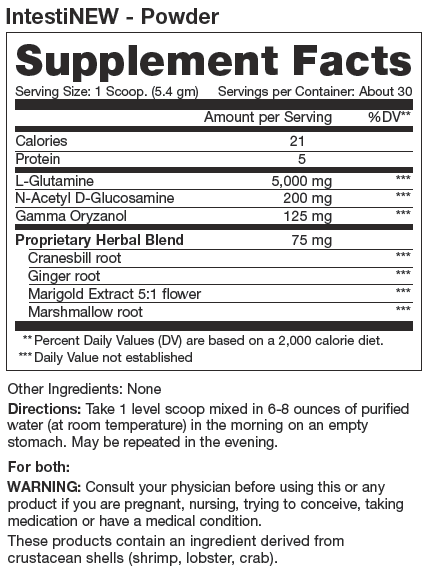
Our gut microbiomes, the several pounds of micro-organisms living inside our intestines and often referred to as Our Friends with Benefits, affect pretty much every aspect of our health – keeping us well or making us sick.

I wrote about INCREASED GUT PERMEABILITY – CAUSES & CONSEQUENCES in a 10 May 2015 post. Here’s part of that article as background for appreciating the value of a supplement called IntestiNEW that strengthens the intestine’s mucosal lining, where our gut microbiomes reside:
DIGESTION – FROM MOUTH TO ANUS

The human digestive tract runs from the mouth at the top to the anus at the other end. Foreign matter (food) is taken in and partially broken down by chewing in the mouth. It then travels down through the esophagus to the stomach and from there into the small and large intestines, where it is selectively digested. During this trip, various phases of digestion take place and nutrients are extracted and absorbed. The liver, gall bladder, and pancreas, organs that aid in the digestive process, are located along the length of the GI tract.
The total length of the GI tract varies from person to person. In an adult male, the range is 20 to 40 feet. On average, the small intestine in adults is 22 feet long and the large intestine is 5 feet.
As you can intuit, a lot could go wrong during that long trip – and much of that depends on the quality of what you deliver to your mouth as ‘food’.

You can see the location of the mucosal layer (called ‘mucous coat’ in the diagram below) and the intestinal villi in this cross-section of the human small intestine. The empty space in the center, just below the villi (the spikes you see in the image of a healthy mucosal membrane in the image to the left above), is called the lumen, the tube in which food travels through the intestines.

INCREASED GUT PERMEABILITY – AKA LEAKY GUT

Increased gut permeability – also known as hyper-permeable intestines or “leaky gut” – describes the intestinal lining’s having become more porous than it should be so the process of what is allowed out into the body no longer functions properly. Larger, undigested food molecules and other bad things (such as yeasts, toxins, and other forms of waste that normally would continue on and get excreted through the anus) flow freely through these too-large holes in the intestinal lining and enter the bloodstream, where they don’t belong and are treated as dangerous invaders.
The gut’s mucosal layer is thin, delicate – and very important. This is where our probiotic bacteria live, so degrading it also degrades the strength of our immune systems. The probiotics residing in the gut mucosal layer make up 70-90% of the human immune system.
Damage to the gut’s mucosal layer leads to a whole range of serious problems as the body tries to cope with the invaders being released into the bloodstream. Once this lining has become disturbed, allowing problematic things to flow through it into the blood stream, a cycle of chronic irritation begins, leading to chronic inflammation in the body and a whole series of autoimmune conditions.

It is well-known that the composition of the gut lining and its microbiota changes during animal development and can be influenced by environmental factors such as diet, lifestyle, and habitat. (Barker, 2013), (Conlon, 2014) & (Renew Life, undated) So you can see the importance of keeping your gut lining, where those critters live, in good shape. REGENERATION OF THE GUT LINING

The thin lining of our intestines is semi-permeable: a healthy lining membrane allows nutrients to pass from the intestines into the bloodstream and prevents toxins, pathogens, and undigested food from exiting the digestive tract too early. When the lining becomes chronically damaged, allowing toxins, pathogens, and undigested food to enter the bloodstream, chronic inflammation occurs in the body and many negatives, autoimmune health conditions may ensue. (Renew Life, undated)
See AUTOIMMUNE DISEASES: How they develop and how to put them in remission (Hardin, 2014) for more information. A healthy intestinal lining serves many functions, most critical among them:
Continuing the digestive processing of food after it leaves the stomach
Absorbing nutrients from this partially digested food
Preventing harmful bacteria and undigested food particles from entering the bloodstream
Like our skin, the delicate mucosal lining of our small and large intestines sloughs off a layer of cells every 3-5 days and produces new cells to maintain its semi-permeable state. This process requires the amino acid L-Glutamine. (Renew Life, undated). “Small populations of adult stem cells are responsible for the remarkable ability of the epithelial lining of the intestine to be efficiently renewed and repaired throughout life.” (Barker, 2013)
The human body’s GI tract is lined with mucosal tissues primarily comprised of epithelial cells attached to the underlying membrane. Tiny, finger-like projections called villi protrude from the intestinal walls and greatly increase their absorptive and surface areas. “Digested nutrients (including sugars and amino acids) pass into the villi through diffusion. Circulating blood then carries these nutrients away. Unlike the mucosal tissue of the inner surface of the eyelids or the mouth, the epithelial cells which line the inside of the stomach are exposed to much harsher conditions, e.g., acid (i.e., hydrochloric acid), sometimes alcohol, enzymes (e.g., pepsin) for digesting food and waste generated therefrom. Mucous secretion essentially protects the cells on the inside of the stomach and duodenum from damage by acid or enzymes, for example by presenting bicarbonate to neutralize some of the effects of acid on the stomach’s inner lining, as well as inhibitors to block the enzymatic activity. Once the mucous secretions of the epithelial cells stop, the inner lining of the stomach or duodenum would eventually be eroded by the combined action of acid and enzymes, leading to ulcer.” (MEBO, 2009) INTESTINEW IntestiNew is a dietary supplement designed and produced by Renew Life to soothe the digestive system and benefit the health of the mucosal lining of the intestines. It is available as a powder or in capsules.

The capsule form contains L-glutamine, N-acetyl D-glucosamine, gamma oryzanol, cranesbill root, ginger root, marigold flower, marshmallow root, vegetable fiber, and water.

The powder form contains the same ingredients with the exception of the vegetable fiber and water.

The glucosamine, L-glutamine, and the herbs in IntestiNew soothe and support the integrity of the intestinal lining. The gamma oryzanol, a natural extract of rice oat bran, delivers essential antioxidant benefits to the digestive system. (Holt, 2016) Both forms of the supplement are gluten-free and contain no artificial ingredients. Women who are pregnant, nursing, or trying to conceive are advised to consult their physicians before taking IntestiNEW, as are people taking pharmaceutical medications or having a medical condition. The supplements contain an ingredient derived from crustacean shells (shrimp, lobster, and/or crab) so aren’t suitable for people with a shellfish allergy.

Although I couldn’t find any scientific papers on IntestiNEW, it has been well-reviewed by customers on Amazon, iHerb, The Vitamin Shoppe, Vitacost, and National Nutrition. I second those reviews: Since I’ve been taking IntestiNEW, I’ve seen a big improvement in my digestive health. I started with a scoop (5.4 grams) stirred into an eight-ounce glass of filtered water before breakfast and now take two capsules before each meal, with water)
Some of the many ways our gut bacteria affect our health:

My thanks to David Miller, MD, Supplements Specialist at Life Thyme Market in New York City, for recommending IntestiNew to me.

REFERENCES Barker, N. (2013). Adult intestinal stem cells: critical drivers of epithelial homeostasis and regeneration. Nature Reviews Molecular Cell Biology 15: 19–33. See: http://www.nature.com/nrm/journal/v15/n1/full/nrm3721.html Conlon, M.A. et al. (2015). The Impact of Diet and Lifestyle on Gut Microbiota and Human Health. Nutrients. 7(1): 17–44. See: http://www.ncbi.nlm.nih.gov/pmc/articles/PMC4303825/ Hardin, J.R. (26 October 2014). AUTOIMMUNE DISEASES: How they develop and how to put them in remission. See: http://allergiesandyourgut.com/2014/10/26/autoimmune-diseases-develop-put-remission/ Hardin, J.R. (10 May 2015). INCREASED GUT PERMEABILITY – CAUSES & CONSEQUENCES. See: http://allergiesandyourgut.com/2015/05/10/increased-gut-permeability-causes-consequences/ Holt, L. (2016). IntestiNew Reviewed: Does IntestiNew Work? Daily Health Answers. See: https://www.dailyhealthanswers.com/intestinew-reviewed.html MEBO. (2009). Regeneration of Gastro- Intestinal Tract. Human Body Regeneration Sciences. See: http://en.mebo.com/about/ShowInfo.asp?InfoID=1 Renew Life. (undated). INTESTINEW: Natural Ingredients Used Traditionally to Support a Healthy Intestinal Lining. See: http://www.renewlife.com/media/spec_sheets/SpecSheetRNLIntestiNew.pdf © Copyright 2016. Joan Rothchild Hardin. All Rights Reserved.
DISCLAIMER: Nothing on this site or blog is intended to provide medical advice, diagnosis or treatment.
Comments submitted prior to 8/25/2021
Very interesting! I have a few questions: Is there a version of the product for persons unable to consume shellfish? Or are there other sources for this array of healing substances? What would you suggest for repairing leaky gut besides this product for vegetarians?
Sonnische
In reply to Sonnische
Sonnische,
Of the ingredients in IntestiNEW Powder, it seems to be the N-ACETYL GLUCOSAMINE that’s derived from the outer shells of crustaceans. (WebMD. (2016) N – ACETYL GLUCOSAMINE. See: http://www.webmd.com/vitamins-supplements/ingredientmono-619-n-acetyl%20glucosamine.aspx?activeingredientid=619&activeingredientname=n-acetyl%20glucosamine )
This is the entire ingredients list for IntestiNEW Powder:
L-GLUTAMINE – 5000mg
N-ACETYL GLUCOSAMINE – 200mg
GAMMA-ORYZANOL (Oryza sativa – rice bran oil) – 125mg
CRANESBILL ROOT (Geranium maculatum) – 18.75mg
GINGER ROOT (Zingiber officinale)- 18.75mg
MARIGOLD FLOWER (Calendula officinalis) – 18.75mg
MARSHMALLOW ROOT (Althaea officinalis) – 18.75mg
A lot of people take L-GLUTAMINE Powder alone, the main ingredient in
IntestiNew, to repair their gut linings & keep them in good shape. I
used to take L-Glutamine Powder (Designs for Health) – 2 tsps mixed
into water before breakfast & dinner – but find IntestiNEW more helpful.
Here’s info on L-GLUTAMINE: WebMD. 2016). GLUTAMINE. See: http://www.webmd.com/vitamins-supplements/ingredientmono-878-glutamine.aspx?activeingredientid=878&activeingredientname=glutamine
Info on GAMMA ORYZANOL: WebMD. (2016) GAMMA ORYZANOL. See: http://www.webmd.com/vitamins-supplements/ingredientmono-770-gamma%20oryzanol.aspx? activeingredientid=770&activeingredientname=gamma%20oryzanol
The other ingredients in IntestiNEW Powder are from roots & flowers.
This article by Dr Axe describes his recommendations for repairing a leaky gut:
Axe, J. (2014). 4 Steps to Heal Leaky Gut and Autoimmune Disease. See: http://draxe.com/4-steps-to-heal-leaky-gut-and-autoimmune-disease/
Years ago a psychiatrist who specialized in treating what was then called Multiple Personality Disorder, recommended L-GLUTAMINE to one of my patients to prevent her migraines, which I know you have too. This is what he told me:
MIGRAINE PREVENTION
Help for Migraines/Other Headaches If you are genetically predisposed to get migraines or other tension headaches this was Dr B’s explanation for how it works: Ammonia builds up in the brain from trying to force thinking and causes both migraines and some other headaches. Glutamic Acid, an amino acid, neutralizes ammonia build up. Glutamic Acid is also called L-Glutamine.
He suggested taking one capsule four times a day as a preventative (can try two capsules four times a day if no result). If it works for you, he said it could decrease the frequency and intensity of migraine headaches and other tension headaches. The L-Glutamine to be taken preventatively. Once the headache has begun, taking it won’t stop a migraine. Glutamic Acid sometimes causes stomach upset. If this happens, Dr B recommended reducing the dose or taking an antacid. (I don’t recall if he recommended Alka Seltzer or Tums). This helped my patient enormously. A family member also tried it, taking as much as 6 Glutamic Acid capsules a day. He sometimes took all 6 at bedtime and hardly ever has a migraine now – and his other intense headaches are no longer as severe or long lasting. I’m told that big doses of L-GLUTAMINE can be problematic for some people but don’t know why. Would be a good idea to talk to your headache doc before trying it. This is what Dr Mercola has to say about how to prevent migraines – he doesn’t mention L-GLUTAMINE but does connect them to food allergies:
Mercola, R. (12/24/2012). How Diet and Supplements Can Help Prevent Migraines. See: http://articles.mercola.com/sites/articles/archive/2012/12/24/food-allergies-trigger-migraines.aspx
Joan Hardin
PLEASE NOTE: I am not a medical doctor and am not offering this as medical advice.
-JRH

